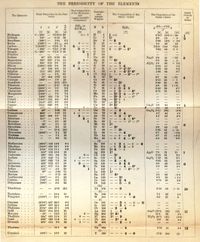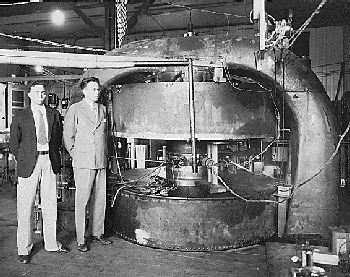| History of the Periodic Table
The Periodic Table of Elements is a chart created by Dmitri Mendeleev in 1869 to help organize the elements that had been discovered
at that time.
First we have to understand what an element is. All matter is made up of elements, which are substances with only one type of
atom. They
have the same number of neutrons,
protons, and
electrons. If you alter the number of the neutrons, protons, or electrons for any element
an isotope is created. There are 92 elements that occur naturally and are found in nature.
Hydrogen, carbon,
nitrogen, and oxygen are
found in most living organisms.
It is a substance that has only one type of atom. They have the same number of neutrons, protons and electrons. When you change the number
of the neutrons, protons or electrons for any element you have created an
isotope of that element.
Elements have been known to man since the ancient times. Sulfur is referred to in the Bible as brimstone and there are other references
to other elements dating back to early times. To understand more about how the periodic table came into existence, there are some
important dates to look at:
1669 - Hennig Brand
invented the Philosopher's Stone, which could turn metals into pure
gold. He also discovered phosphorus. 1680 - Robert
Boyle also discovered phosphorus without knowing about Hennig Brand's discovery. By 1809 about 47 elements had been discovered and named. Scientists began
to see patterns in their atom structures. 1863 - John
Newlands organized the 56 then known elements into eleven separate groups based upon their atom structure. 1869 - Dimitri Mendellev used John Newlands'
grouping and organized the elements into what is now known as the periodic table. He used the atomic mass as the primary
characteristic to decide where each element belonged in his table. The elements were arranged in rows and columns. He
even left spaces for elements to be discovered because of the pattern he saw once he started organizing those elements known
at that that time. His table looked like this:
Picture courtesy of
Answers.com
1886 - Antoine Becquerel discovered radioactivity. 1886 -
Ernest Rutherford named three types of radiation:
alpha and
beta and
gamma rays. 1886 - Pierre and Marie
Curie began their work and discovered radium and
polonium. They also discovered that beta particles were negatively charged. 1894 -
Sir William Ramsay and Lord Rayleigh
discovered the noble gases and they were added to the periodic table as group O. 1897 - J. J.
Thomson discovered electrons which were small negatively charged particles. 1897 - John
Sealy Townsend and
Robert
A. Millikan further investigated
electrons and were able to determine their exact charge and mass. 1900 - Antoine Becquerel discovered that electrons and beta particles were
the same thing. 1903 -
Ernest Rutherford decided that radioactivity is what caused atoms to be broken down. 1911 -
Ernest Rutherford and Hans Geiger discovered that electrons moved around the nucleus of the cell's atom much like planets orbit the sun. 1913 - Niels
Bohr discovered the electrons' orbits and that there were more electrons in the outer orbits than in the inner orbits. He also
saw that radiation was emitted when an electron would jump from one orbit to another. 1914 -
Ernest Rutherford discovered protons in the nucleus. 1914 - Henry Moseley
labeled the elements with atomic numbers based upon the number of electrons in an atom rather than on their atomic mass. 1932 -
James Chadwick discovered neutrons and identified isotopes. 1932 -
J. D. Cockroft and Ernest T. S.
Walton worked together in splitting the atom when working with lithium which they bombarded with protons. The lithium
nucleus was divided into two helium nuclei. 1932 - Ernest O.
Lawrence, Milton Stanley Livingston and Milton White
worked on the first cyclotron at the University of California in Berkeley.
A cyclotron is in the picture below.
Picture courtesy of
The Manhattan Project
1945 -
Glenn Seaborg identified lanthanides and actinides which are elements with atomic numbers higher than 92 and are placed in a separate section
on the bottom in today's Periodic Table. As of October 16, 2006 there are 117 different elements. The most recent
elements discovered are meitnerium, darmstadtium, and ununquadium.
For more information on the discovery of the elements, go to The Manhattan
Project and Development of the Periodic Table.
|

